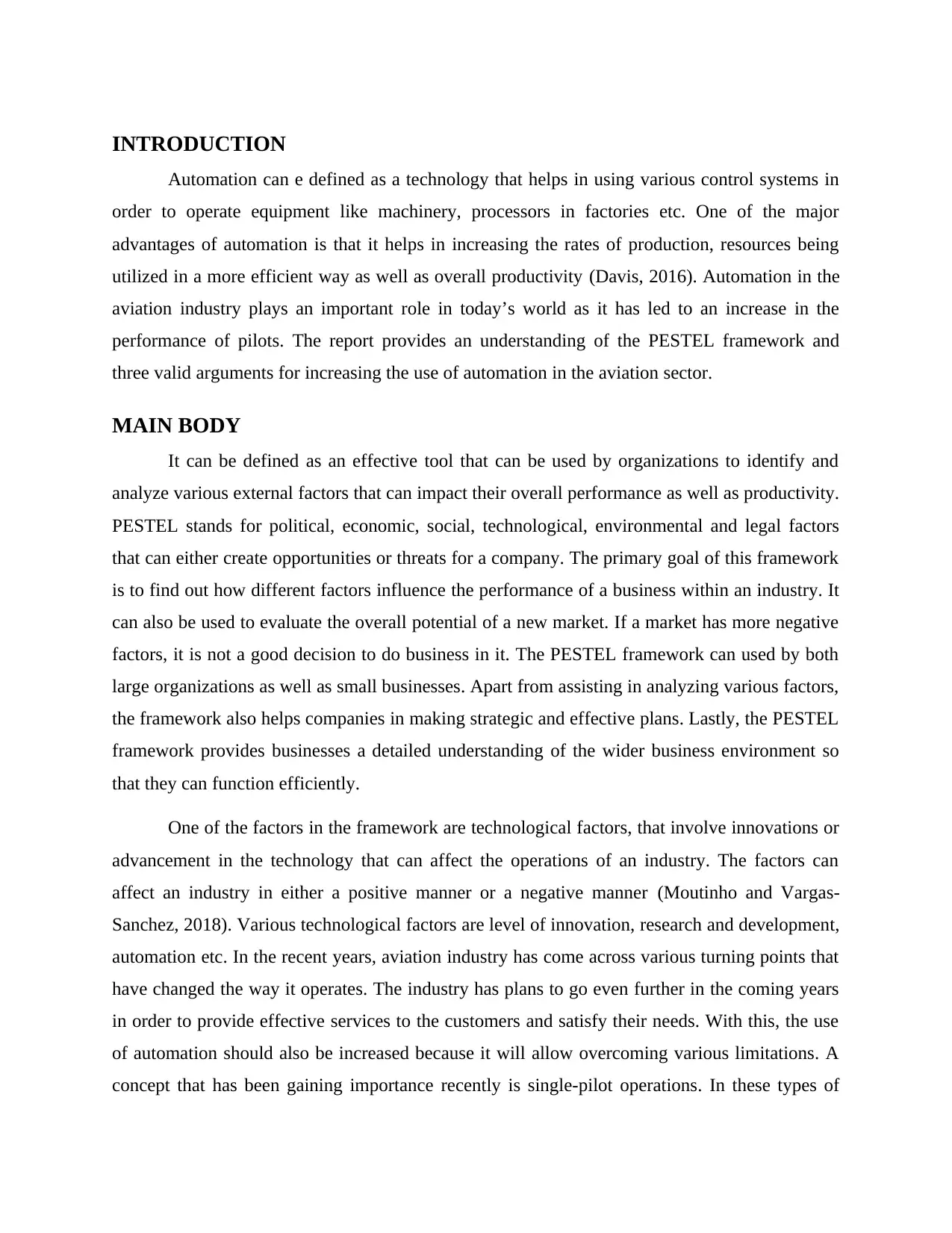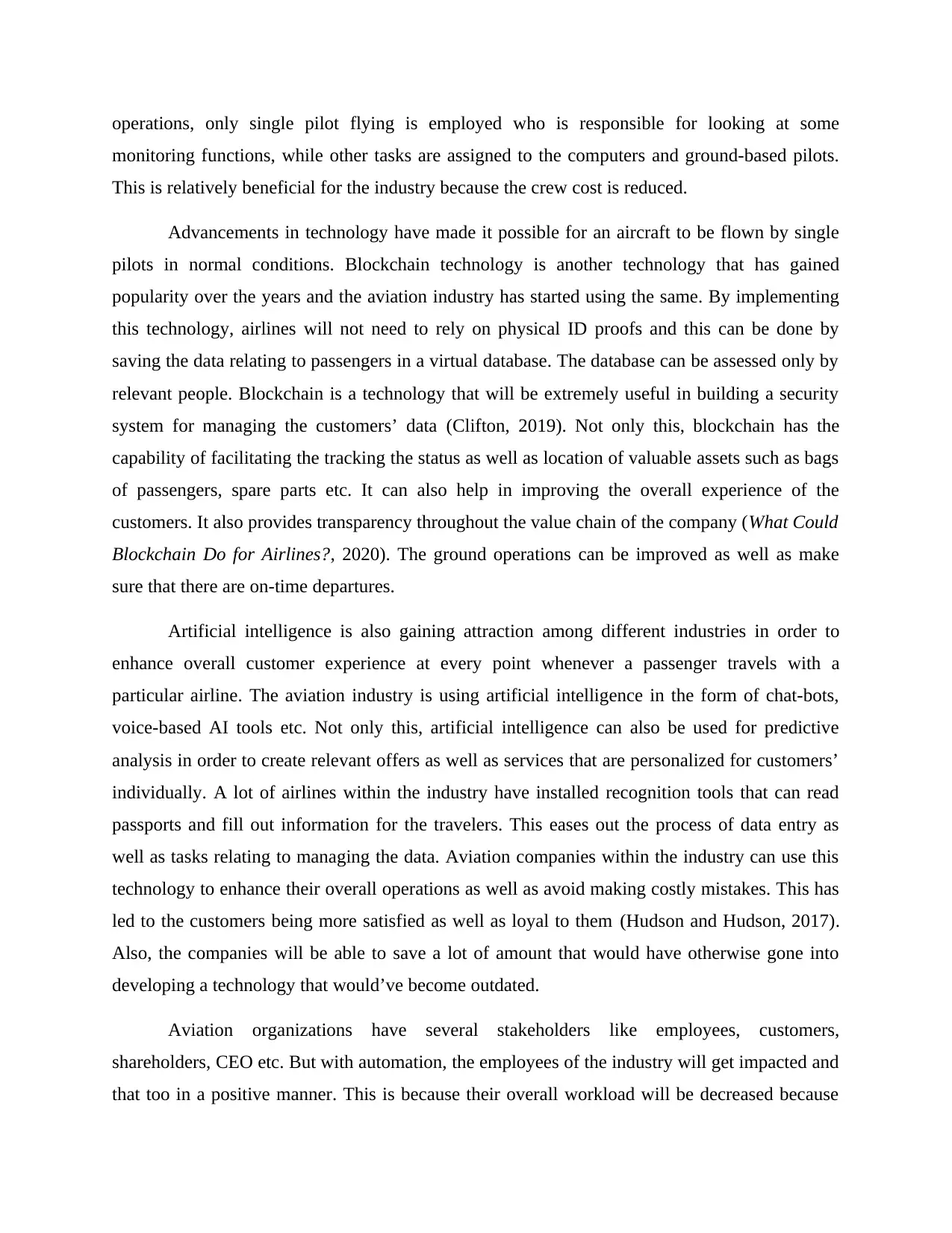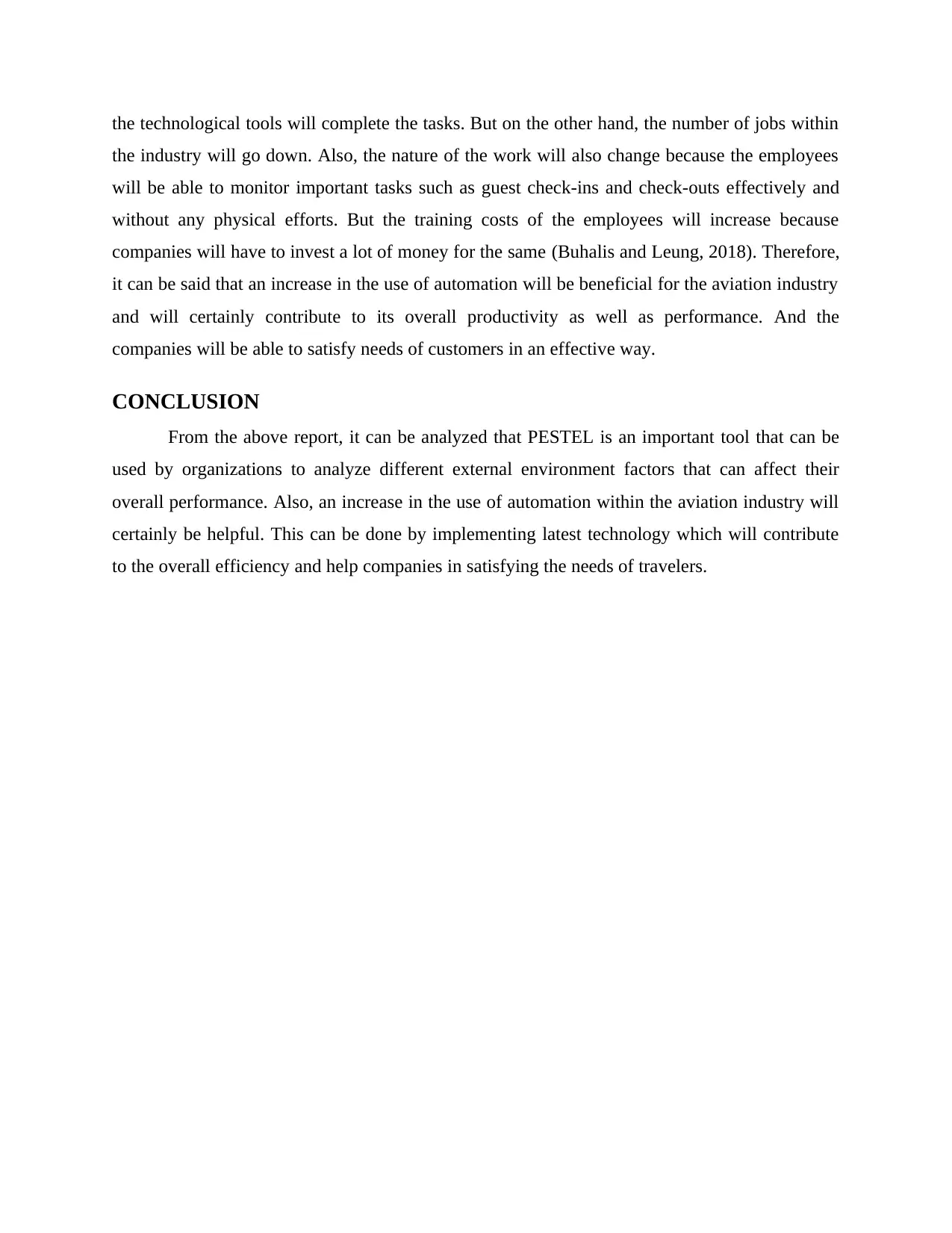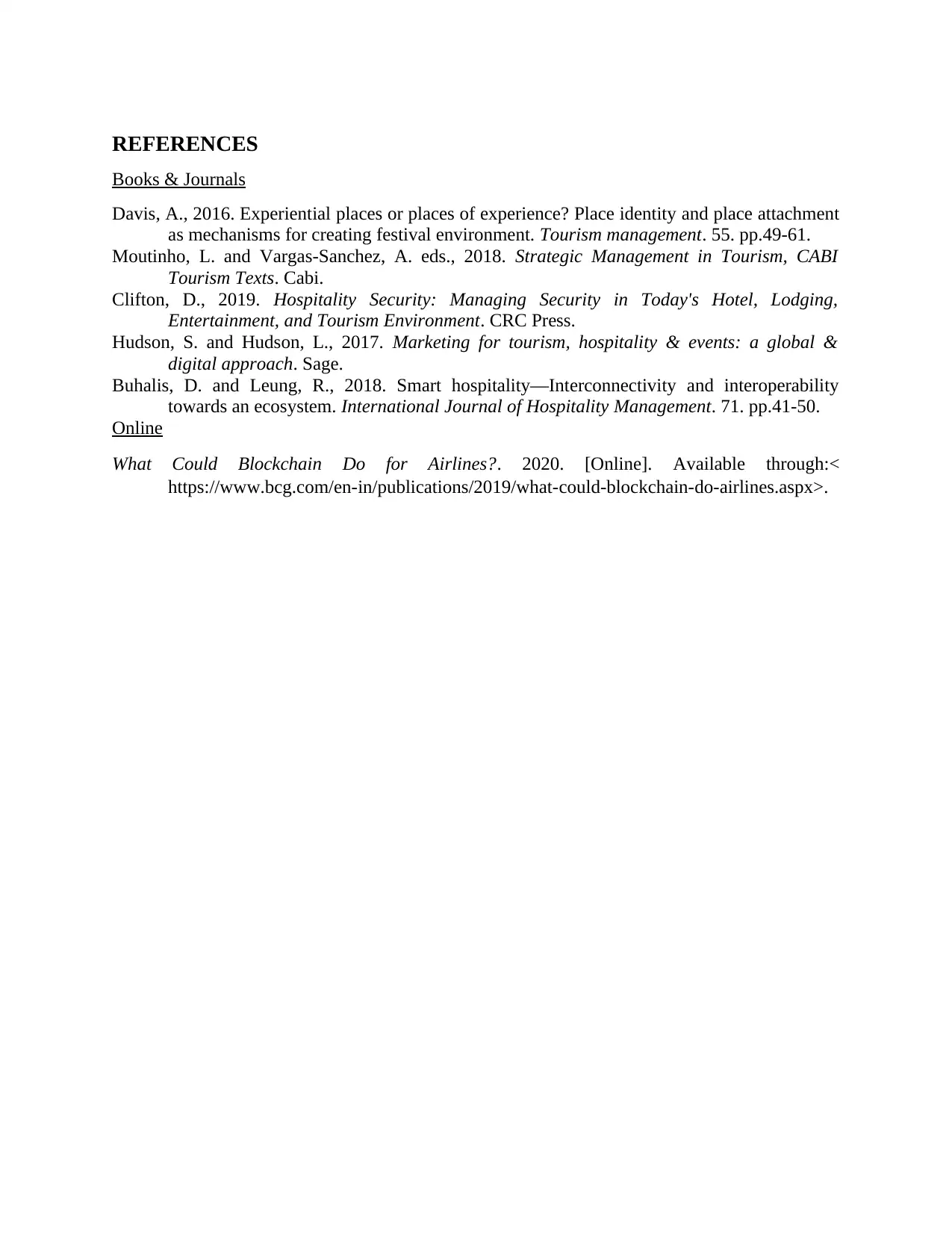PESTEL Framework, Automation, and Aviation Industry Analysis Report
VerifiedAdded on 2023/01/11
|6
|1312
|59
Report
AI Summary
This report examines the role of automation within the aviation industry, focusing on its benefits and implications. It begins with an introduction to automation and its advantages, followed by an analysis using the PESTEL framework to identify political, economic, social, technological, environmental, and legal factors impacting the industry. The main body explores specific technological advancements like single-pilot operations, blockchain technology, and artificial intelligence, detailing their applications and advantages. It also discusses the impact of automation on aviation stakeholders, including employees, customers, and shareholders. The report concludes by emphasizing the importance of automation for enhancing efficiency, customer satisfaction, and overall performance within the aviation sector. The report uses Harvard referencing for all sources cited.

Hospitality, Tourism,
Events Environment
Events Environment
Paraphrase This Document
Need a fresh take? Get an instant paraphrase of this document with our AI Paraphraser

Contents
INTRODUCTION.....................................................................................................................................3
MAIN BODY.............................................................................................................................................3
CONCLUSION..........................................................................................................................................5
REFERENCES..........................................................................................................................................6
INTRODUCTION.....................................................................................................................................3
MAIN BODY.............................................................................................................................................3
CONCLUSION..........................................................................................................................................5
REFERENCES..........................................................................................................................................6

INTRODUCTION
Automation can e defined as a technology that helps in using various control systems in
order to operate equipment like machinery, processors in factories etc. One of the major
advantages of automation is that it helps in increasing the rates of production, resources being
utilized in a more efficient way as well as overall productivity (Davis, 2016). Automation in the
aviation industry plays an important role in today’s world as it has led to an increase in the
performance of pilots. The report provides an understanding of the PESTEL framework and
three valid arguments for increasing the use of automation in the aviation sector.
MAIN BODY
It can be defined as an effective tool that can be used by organizations to identify and
analyze various external factors that can impact their overall performance as well as productivity.
PESTEL stands for political, economic, social, technological, environmental and legal factors
that can either create opportunities or threats for a company. The primary goal of this framework
is to find out how different factors influence the performance of a business within an industry. It
can also be used to evaluate the overall potential of a new market. If a market has more negative
factors, it is not a good decision to do business in it. The PESTEL framework can used by both
large organizations as well as small businesses. Apart from assisting in analyzing various factors,
the framework also helps companies in making strategic and effective plans. Lastly, the PESTEL
framework provides businesses a detailed understanding of the wider business environment so
that they can function efficiently.
One of the factors in the framework are technological factors, that involve innovations or
advancement in the technology that can affect the operations of an industry. The factors can
affect an industry in either a positive manner or a negative manner (Moutinho and Vargas-
Sanchez, 2018). Various technological factors are level of innovation, research and development,
automation etc. In the recent years, aviation industry has come across various turning points that
have changed the way it operates. The industry has plans to go even further in the coming years
in order to provide effective services to the customers and satisfy their needs. With this, the use
of automation should also be increased because it will allow overcoming various limitations. A
concept that has been gaining importance recently is single-pilot operations. In these types of
Automation can e defined as a technology that helps in using various control systems in
order to operate equipment like machinery, processors in factories etc. One of the major
advantages of automation is that it helps in increasing the rates of production, resources being
utilized in a more efficient way as well as overall productivity (Davis, 2016). Automation in the
aviation industry plays an important role in today’s world as it has led to an increase in the
performance of pilots. The report provides an understanding of the PESTEL framework and
three valid arguments for increasing the use of automation in the aviation sector.
MAIN BODY
It can be defined as an effective tool that can be used by organizations to identify and
analyze various external factors that can impact their overall performance as well as productivity.
PESTEL stands for political, economic, social, technological, environmental and legal factors
that can either create opportunities or threats for a company. The primary goal of this framework
is to find out how different factors influence the performance of a business within an industry. It
can also be used to evaluate the overall potential of a new market. If a market has more negative
factors, it is not a good decision to do business in it. The PESTEL framework can used by both
large organizations as well as small businesses. Apart from assisting in analyzing various factors,
the framework also helps companies in making strategic and effective plans. Lastly, the PESTEL
framework provides businesses a detailed understanding of the wider business environment so
that they can function efficiently.
One of the factors in the framework are technological factors, that involve innovations or
advancement in the technology that can affect the operations of an industry. The factors can
affect an industry in either a positive manner or a negative manner (Moutinho and Vargas-
Sanchez, 2018). Various technological factors are level of innovation, research and development,
automation etc. In the recent years, aviation industry has come across various turning points that
have changed the way it operates. The industry has plans to go even further in the coming years
in order to provide effective services to the customers and satisfy their needs. With this, the use
of automation should also be increased because it will allow overcoming various limitations. A
concept that has been gaining importance recently is single-pilot operations. In these types of
⊘ This is a preview!⊘
Do you want full access?
Subscribe today to unlock all pages.

Trusted by 1+ million students worldwide

operations, only single pilot flying is employed who is responsible for looking at some
monitoring functions, while other tasks are assigned to the computers and ground-based pilots.
This is relatively beneficial for the industry because the crew cost is reduced.
Advancements in technology have made it possible for an aircraft to be flown by single
pilots in normal conditions. Blockchain technology is another technology that has gained
popularity over the years and the aviation industry has started using the same. By implementing
this technology, airlines will not need to rely on physical ID proofs and this can be done by
saving the data relating to passengers in a virtual database. The database can be assessed only by
relevant people. Blockchain is a technology that will be extremely useful in building a security
system for managing the customers’ data (Clifton, 2019). Not only this, blockchain has the
capability of facilitating the tracking the status as well as location of valuable assets such as bags
of passengers, spare parts etc. It can also help in improving the overall experience of the
customers. It also provides transparency throughout the value chain of the company (What Could
Blockchain Do for Airlines?, 2020). The ground operations can be improved as well as make
sure that there are on-time departures.
Artificial intelligence is also gaining attraction among different industries in order to
enhance overall customer experience at every point whenever a passenger travels with a
particular airline. The aviation industry is using artificial intelligence in the form of chat-bots,
voice-based AI tools etc. Not only this, artificial intelligence can also be used for predictive
analysis in order to create relevant offers as well as services that are personalized for customers’
individually. A lot of airlines within the industry have installed recognition tools that can read
passports and fill out information for the travelers. This eases out the process of data entry as
well as tasks relating to managing the data. Aviation companies within the industry can use this
technology to enhance their overall operations as well as avoid making costly mistakes. This has
led to the customers being more satisfied as well as loyal to them (Hudson and Hudson, 2017).
Also, the companies will be able to save a lot of amount that would have otherwise gone into
developing a technology that would’ve become outdated.
Aviation organizations have several stakeholders like employees, customers,
shareholders, CEO etc. But with automation, the employees of the industry will get impacted and
that too in a positive manner. This is because their overall workload will be decreased because
monitoring functions, while other tasks are assigned to the computers and ground-based pilots.
This is relatively beneficial for the industry because the crew cost is reduced.
Advancements in technology have made it possible for an aircraft to be flown by single
pilots in normal conditions. Blockchain technology is another technology that has gained
popularity over the years and the aviation industry has started using the same. By implementing
this technology, airlines will not need to rely on physical ID proofs and this can be done by
saving the data relating to passengers in a virtual database. The database can be assessed only by
relevant people. Blockchain is a technology that will be extremely useful in building a security
system for managing the customers’ data (Clifton, 2019). Not only this, blockchain has the
capability of facilitating the tracking the status as well as location of valuable assets such as bags
of passengers, spare parts etc. It can also help in improving the overall experience of the
customers. It also provides transparency throughout the value chain of the company (What Could
Blockchain Do for Airlines?, 2020). The ground operations can be improved as well as make
sure that there are on-time departures.
Artificial intelligence is also gaining attraction among different industries in order to
enhance overall customer experience at every point whenever a passenger travels with a
particular airline. The aviation industry is using artificial intelligence in the form of chat-bots,
voice-based AI tools etc. Not only this, artificial intelligence can also be used for predictive
analysis in order to create relevant offers as well as services that are personalized for customers’
individually. A lot of airlines within the industry have installed recognition tools that can read
passports and fill out information for the travelers. This eases out the process of data entry as
well as tasks relating to managing the data. Aviation companies within the industry can use this
technology to enhance their overall operations as well as avoid making costly mistakes. This has
led to the customers being more satisfied as well as loyal to them (Hudson and Hudson, 2017).
Also, the companies will be able to save a lot of amount that would have otherwise gone into
developing a technology that would’ve become outdated.
Aviation organizations have several stakeholders like employees, customers,
shareholders, CEO etc. But with automation, the employees of the industry will get impacted and
that too in a positive manner. This is because their overall workload will be decreased because
Paraphrase This Document
Need a fresh take? Get an instant paraphrase of this document with our AI Paraphraser

the technological tools will complete the tasks. But on the other hand, the number of jobs within
the industry will go down. Also, the nature of the work will also change because the employees
will be able to monitor important tasks such as guest check-ins and check-outs effectively and
without any physical efforts. But the training costs of the employees will increase because
companies will have to invest a lot of money for the same (Buhalis and Leung, 2018). Therefore,
it can be said that an increase in the use of automation will be beneficial for the aviation industry
and will certainly contribute to its overall productivity as well as performance. And the
companies will be able to satisfy needs of customers in an effective way.
CONCLUSION
From the above report, it can be analyzed that PESTEL is an important tool that can be
used by organizations to analyze different external environment factors that can affect their
overall performance. Also, an increase in the use of automation within the aviation industry will
certainly be helpful. This can be done by implementing latest technology which will contribute
to the overall efficiency and help companies in satisfying the needs of travelers.
the industry will go down. Also, the nature of the work will also change because the employees
will be able to monitor important tasks such as guest check-ins and check-outs effectively and
without any physical efforts. But the training costs of the employees will increase because
companies will have to invest a lot of money for the same (Buhalis and Leung, 2018). Therefore,
it can be said that an increase in the use of automation will be beneficial for the aviation industry
and will certainly contribute to its overall productivity as well as performance. And the
companies will be able to satisfy needs of customers in an effective way.
CONCLUSION
From the above report, it can be analyzed that PESTEL is an important tool that can be
used by organizations to analyze different external environment factors that can affect their
overall performance. Also, an increase in the use of automation within the aviation industry will
certainly be helpful. This can be done by implementing latest technology which will contribute
to the overall efficiency and help companies in satisfying the needs of travelers.

REFERENCES
Books & Journals
Davis, A., 2016. Experiential places or places of experience? Place identity and place attachment
as mechanisms for creating festival environment. Tourism management. 55. pp.49-61.
Moutinho, L. and Vargas-Sanchez, A. eds., 2018. Strategic Management in Tourism, CABI
Tourism Texts. Cabi.
Clifton, D., 2019. Hospitality Security: Managing Security in Today's Hotel, Lodging,
Entertainment, and Tourism Environment. CRC Press.
Hudson, S. and Hudson, L., 2017. Marketing for tourism, hospitality & events: a global &
digital approach. Sage.
Buhalis, D. and Leung, R., 2018. Smart hospitality—Interconnectivity and interoperability
towards an ecosystem. International Journal of Hospitality Management. 71. pp.41-50.
Online
What Could Blockchain Do for Airlines?. 2020. [Online]. Available through:<
https://www.bcg.com/en-in/publications/2019/what-could-blockchain-do-airlines.aspx>.
Books & Journals
Davis, A., 2016. Experiential places or places of experience? Place identity and place attachment
as mechanisms for creating festival environment. Tourism management. 55. pp.49-61.
Moutinho, L. and Vargas-Sanchez, A. eds., 2018. Strategic Management in Tourism, CABI
Tourism Texts. Cabi.
Clifton, D., 2019. Hospitality Security: Managing Security in Today's Hotel, Lodging,
Entertainment, and Tourism Environment. CRC Press.
Hudson, S. and Hudson, L., 2017. Marketing for tourism, hospitality & events: a global &
digital approach. Sage.
Buhalis, D. and Leung, R., 2018. Smart hospitality—Interconnectivity and interoperability
towards an ecosystem. International Journal of Hospitality Management. 71. pp.41-50.
Online
What Could Blockchain Do for Airlines?. 2020. [Online]. Available through:<
https://www.bcg.com/en-in/publications/2019/what-could-blockchain-do-airlines.aspx>.
⊘ This is a preview!⊘
Do you want full access?
Subscribe today to unlock all pages.

Trusted by 1+ million students worldwide
1 out of 6
Related Documents
Your All-in-One AI-Powered Toolkit for Academic Success.
+13062052269
info@desklib.com
Available 24*7 on WhatsApp / Email
![[object Object]](/_next/static/media/star-bottom.7253800d.svg)
Unlock your academic potential
Copyright © 2020–2025 A2Z Services. All Rights Reserved. Developed and managed by ZUCOL.





